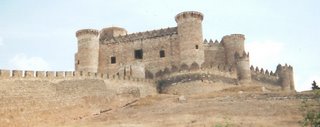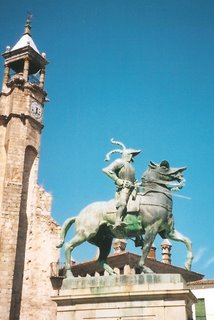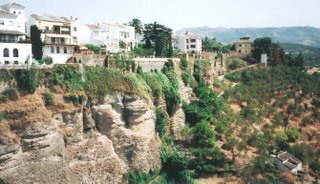In Guadalupe, in the Extremadura section toward the west, is a lovely old cathedral with a Black Madonna, very small in size and said to have been carved by St. Luke - found in 1325, buried. The explanation for the dark skin is the length of time buried, but many other black madonnas were not buried, not scorched, and still are black. See picture at www.solt3.org/guadalupespain.
The guidebook there does not mention the color, but internet sites tracking and mapping the black madonnas give more detail. Broad spectrum of approaches - see, for example, saxakali.com/suzar/madonna; and altreligion.about.com/library/bl_blackvirgins, and en.wikipedia.org/wiki/Black_Madonna. No pictures were permitted - we wish we had.
The figure is triangular, small head, stiff triangle shape robes. See her at your own Images search for Guadalupe Black Madonna, or at ://sacredsites.com/shop/index.php?main_page=product_info&products_id=117. Read some background of the black madonnas at ://www.womenreligious.org/~education/Mariology3/Read/Readings_3/BlackMadonna.htm
We were two people, heading out, an improvised road trip. This site is being revised for relevance to this new Covid-and-upheaval world. The itinerary remains: Madrid, Pamplona, Cuenca, La Mancha, Toledo, Salamanca, Avila, Trujillo, Seville, Cadiz (then British Gibraltar), Granada, Cordoba (photo), Madrid. 2. Barcelona, Roses, Figueres, Ripoll, Seu d'Urguell [Andorra; then France]. Roncesvalles, Jaca, Huesca, Graus, Barcelona. Routine cites to history sources may be deleted.
Sunday, December 31, 2006
Sunday, December 24, 2006
La Mancha, Spain. Windmills Old and New.
 La Mancha, Spain. Windmills.
La Mancha, Spain. Windmills.Old windmills. There are many, but they may well be merely preserved rather than fully depended upon. These are in La Mancha, area of Don Quixote.
Modern windmills were not as intrusive as we expected, but we understand the extreme hazard to migrating birds. The windfarms are huge. And, residents in the area may find the noise unacceptable. .
Modern windmill farm, Spain.
Modern windmills: These are on the road from Burgos toward Bilbao. Look closely. They make such sense, and are better for emissions than refineries. Issues remain about how to protect birds and the like, so we remain interested. See Netherlands Road Ways, windmills post.
For the variety of windmills in Europe, add the Polish style, many such windmills destroyed by the Nazis as part of systemic impoverishment, see post at Poland Road Ways, Windmills.
 Windmill farm, on way to Pamplona, Spain
Windmill farm, on way to Pamplona, SpainTaking pictures in the countries we visit is haphazard - secondary to our having a good time and learning history.
For a fine site for photographs, see http://www.pbase.com/bauer/spain.
Wednesday, December 20, 2006
Avila - Teresa's Town
 Here are the walls surrounding Avila, the home of St. Teresa (died in the mid-1500's), see www.karmel.at/eng/teresa. St. Theresa is a favorite for those of us who like Bernini's 1652 sculpture of her swooning, with her shoe dangling off her bare foot. See www.stmarys-ca.edu/magazine/v26/4/teresa.
Here are the walls surrounding Avila, the home of St. Teresa (died in the mid-1500's), see www.karmel.at/eng/teresa. St. Theresa is a favorite for those of us who like Bernini's 1652 sculpture of her swooning, with her shoe dangling off her bare foot. See www.stmarys-ca.edu/magazine/v26/4/teresa.The town of Avila, www.cyberspain.com/ciudades-patrimonio/iavila, where she was from, has standing medieval walls, there were some 90 towers, and the museum is a fine display of her work.
She is especially dear because she had relationships, attractions, waffled in her faith, like Mother Teresa. See ://www.christianitytoday.com/history/special/131christians/avila.html. Nothing is certain, no matter how much we may want it to be. Is that right? Cheer on the searchers, and keep your own dishes washed. And, was she part Jewish? See ://www.mcs.drexel.edu/~gbrandal/Illum_html/Teresa.html. Pursue that if it is of interest to you. The Jews were expelled from Spain in 1492.
Labels:
Avila,
Bernini,
Jewish quarter,
sculpture,
St. Teresa,
towers,
walled city
Thursday, December 14, 2006
Castles, Crusades. Cultural, Religious Protection for Crusaders. St. Bernard of Clairvaud. Compare Jihad.
 Castle, Spain, roadside view in passing.
Castle, Spain, roadside view in passing.Castles in Spain.
Castles are visible all over Spain. Moors occupied Spain from the 800's until the final Reconquest by Spain's royalty and others by 1492. The process of reconquest took centuries, chipping away. The pointed arch-shaped crenellations here look Moorish, but the flat crenellations look like later Crusader work. How to research?
From the visible remains of the Moorish time, in architecture, food, and a flowering of its culture (Jews and Christians could remain, under "dhimmitude" restrictions, but still participating in the culture), take some time to research the religion, the mindsets in conflict. *
Many castles were used as Crusader* castles, even if original structures were Moorish. They were often also repurposed in the Reconquest of Ferdinand and Isabella. See http://www.historyguide.org/ancient/lecture25b. Some castle were built by one group, then used by successive powers.
This one, identity unknown, resembles Castle La Mota where Queen Juana la Loca was imprisoned. She is buried at the Cathedral at Granada, with her husband, Philip; and with Ferdinand and Isabella. Read the site for a view of life in one of these castles, involuntarily there. Spain Road Ways, Granada.
...........................................................................
*The Crusader Mindset. Definitive for the Middle Ages.
1. The West was ultimately beaten, soundly, and the Crusades a failure.And the West was trounced. It was the Western equivalent of a Jihad in some ways, except that Jihad is, I believe, a defensive matter. The one who is targeted has to commit an act so egregious, so much a part of a pattern, that the Jihad response is required, part of the submission required to be good. Jihad means to strive, and is part of a process, not engaged in as an isolated or personal matter. Everyman's overview: start at http://www.answers.com/topic/jihad/
My understanding is that Jihad is, ultimately, the desire to do what is needed, and that which is seen as an ultimate good, but to do it defensively - see http://www.submission.org/muhammed/jihad.html; whereas, the West loves the Offense. Which is worse?As you research, note that you will not find "translations" of the Koran. It cannot be translated. The closest would be the designation of "meaning of the Koran". See Pickthall's Meaning of the Koran at http://www.khayma.com/librarians/call2islaam/quran/pickthall/index.html.
2. Find parallels to Jihad, but as an offensive and not defensive matter, in the West: Look for the concept of "evildoers". That idea, that evildoers as defined by the Popes and others, had such non-human characteristics that they could be killed with impunity. It was not a sin. A crusader's sins would be forgiven, if going off to the crusades. Who could resist?
EVILDOERS IN MOTIVATING FOR THE CRUSADES
Religious protection for Crusaders
SAINT BERNARD OF CLAIRVAUX: 1090-1153
"Neither dealing out death nor dying, when for Christ's sake, contains anything criminal but rather merits glorious reward.
"The soldier of Christ kills safely and dies the more safely.
"Not without cause does he bear the sword. He is the instrument of God for the punishment of evildoers and for the defense of the just.
"When he kills evildoers it is not homicide, but malicide, and he is considered Christ's legal executioner."
St. Bernard of Clairvaux thus drummed up enthusiasm for the first Crusade, as quoted at http://www.the-orb.net/encyclop/religion/monastic/bernard. Do a "find" for "evildoers" and come to the passage where killing an evildoer is not killing a man, so it is ok.
A similar description of the dehumanization of the Muslims. Killing not a sin.
"If he kills an evildoer, he is not a mankiller, but, if I may so put it, a killer of evil.
"He is evidently the avenger of Christ towards evildoers and he is rightly considered a defender of Christians.
"Should he be killed himself, we know that he has not perished, but has come safely into port.
"When he inflicts death it is to Christ's profit, and when he suffers death, it is for his own gain.
"The Christian glories in the death of the pagan, because Christ is glorified; while the death of the Christian gives occasion for the King to show his liberality in the rewarding of his knight."
The past offers a window to the present. Cultural attitudes remain. President Bush favored the terminology "evildoers" -- See http://www.archives.cnn.com/2001/US/09/16/gen.bush.terrorism/. Do your own search.
Tuesday, December 12, 2006
Tapas and food
Any Plaza Major. Head for the main square. Eat outdoors and order at random. Point to unknowns, or to someone else's plate, and take what comes.Tapas. Bite-size. Eat until full.
Oreilles: You may think you are ordering little pasta ear-shells, and in will come braised pig's ears. A little salty, but cartilagenous and tasty. Recipes: oreja de oro at recipes.caribseek.com/Curacao/salted-pigs-ears. See also fooddownunder.com/cgi-bin/recipe.cgi?r=21214.
Here is another write-up on tapas and food -Rick Steves (excellent travel guides) at www.ricksteves.com/plan/destinations/spain/tapas0008. For an overview of the individualized portions of many things - appetizers that can become an entire meal - see www.arrakis.es/%7Ejols/tapas/indexin.
Here is a site that talks about beef showing up on menus now, but this was not always the case. See the huge menu of environmental, climate and other nature items in Spain, materwww.iberianature.com. Scroll down the right menu to the food in Spain section, and then to beef.
Restaurants with tablecloths: beware, unless you plan to pay restaurant prices.
More blogs about Spain Road Ways.

Oreilles: You may think you are ordering little pasta ear-shells, and in will come braised pig's ears. A little salty, but cartilagenous and tasty. Recipes: oreja de oro at recipes.caribseek.com/Curacao/salted-pigs-ears. See also fooddownunder.com/cgi-bin/recipe.cgi?r=21214.
Here is another write-up on tapas and food -Rick Steves (excellent travel guides) at www.ricksteves.com/plan/destinations/spain/tapas0008. For an overview of the individualized portions of many things - appetizers that can become an entire meal - see www.arrakis.es/%7Ejols/tapas/indexin.
Here is a site that talks about beef showing up on menus now, but this was not always the case. See the huge menu of environmental, climate and other nature items in Spain, materwww.iberianature.com. Scroll down the right menu to the food in Spain section, and then to beef.
Restaurants with tablecloths: beware, unless you plan to pay restaurant prices.
More blogs about Spain Road Ways.
Labels:
europeroadways,
pig's ears,
plaza major,
Salamanca,
tapas
Monday, December 11, 2006
Estremadura: Guadalupe, Trujllo - Conquistadors; Black Madonna
Trujillo, Spain
Trujillo arises suddenly out of the dust and rock. It is the birthplace of Pizarro, the conquistador that the Financial Times (this an update) calls "a sort of Renaissance Terminator," Issue September 8-9, 2012, article on Lima, Peru. There apparently are some 25000 skeletons in the San Francisco Monastery there: one in particular has been given a fancy sarcophagus, throat slashed, and skewered through an eye. Francisco Pizarro. Plunderer extraordinaire.
 Pizarro, Statue in Trujillo, Spain
Pizarro, Statue in Trujillo, Spain This man obliterated an entire culture. Incas in Peru never recovered.
Does it sound like Simon de Montfort carrying out the orders of Pope Innocent III in decimating the Cathars in the 13th Century Languedoc, France? Of course. But Pizarro was not under shield of a church claiming to speak for God (ye gods) in implementing genocide and reaping the property from it; he went to get rich directly.
He also died in the attempt, as did Simon de Montfort at Toulouse.
More photos: at pahoahi.tripod.com/spain/trujillo; see also an older site, "Celts, Romans, Moors and Christians," and travel guru Frommer at www.frommers.com/destinations/trujillospain/1144010001.html.
There is a fine and well-maintained Moorish castle here as well, and fine palaces from the 16th and 17th Centuries, when the gold ran rich. This statue of Pizarro - an American work, is by Mary Harriman and Charles Runse, says Frommer. Yankee statue?
The Extremadura is a region in the west, see www.infoplease.com/ce6/world/A0818055, and many conquistadores came from the area - Balboa, Cortes and DeSoto, for example. A fine old Moorish palace overlooks the town. See www.trujilloespana.com/about.
Labels:
Balboa,
Black Madonna,
Conquistadors,
Cortes,
DeSoto,
Estremadura,
Pizarro,
Trujillo
Sunday, December 10, 2006
Seville, Cadiz. Roman ruin, roadsixe.
 Seville area, Roman ruins, countryside. Spain
Seville area, Roman ruins, countryside. SpainOn the way to Seville, on a back road, we heard cowbells, stopped for a rest, wandered, found Roman ruins, cattle wading beyond.
First, to Seville, www.andalucia.com/cities/sevilla, and Cadiz, www.alicante-spain.com/costa-del-sol/cadiz.
In Seville, when you go to a flamenco club, sit as far front as possible - the dancers may well spot your companion (Dan was spotted) and the gazes and smiles during the performances are worth a whole trip in itself.
Friday, December 08, 2006
Rock of Gibraltar. Not part of Spain.
This is its own site, since it is a British territory, so see photos at separate site, Gibraltar Road Ways. It is a World Heritage site, see at http://whc.unesco.org/en/list/1500.
 Rock of Gibraltar
Rock of GibraltarEnjoy the apes.
Monday, December 04, 2006
Ronda. Andalusian Cliffs.
 Ronda, Spain. Andalusian Cliffs
Ronda, Spain. Andalusian CliffsRonda - in the mountains, on a deep gorge in Malaga, with a Roman bridge crossing -- the name Ronda is thanks to Julius Caesar. See http://www.travelinginspain.com/Ronda. The site also keys other major towns. This city provided asylum for Moors fleeing the Inquisition after Granada fell. See http://all-that-is-interesting.com/the-rich-history-of-ronda-spain
The old quarter is Moorish. We stayed at a Parador, one in a system of excellent and reasonable hotels throughout Spain. The government interest is in encouraging tourism, and in preserving fine old structures, such as monasteries, palaces, castles, and they keep the exteriors but change the inside. See http://www.parador.es/en/portal.do.
They vary widely in cost, but are worth checking out before driving on. They are convenient and we splurged for the view below. Some are surprisingly inexpensive.
Labels:
Andalusian Cliffs,
Parador,
Roman bridge,
Ronda
Subscribe to:
Posts (Atom)
 Trujillo, Spain
Trujillo, Spain